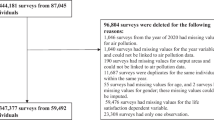Abstract
Since entering the new era, China’s socialist contradiction has been transformed into the contradiction between the people’s growing need for a better life and the unbalanced and inadequate development. How to improve the quality of people’s life through the improvement of air quality has become an important content restricting social development and a key problem to be solved. Based on the life satisfaction (LS) method, this study takes air quality into the individual utility function, and through matching China Health and Retirement Longitudinal Study (CHARLS), two phases of microindividual tracking data with 122 urban environmental quality data innovatively investigate the impact of air quality on residents’ LS and its income substitution effect. The results show that air quality significantly reduces residents’ LS, among which, different air pollutants and comprehensive air quality AQI have significant negative effects. And PM10 has the highest marginal effect on different LS evaluation, SO2 has the smallest marginal effect, and AQI marginal effect is close to PM10. In terms of group heterogeneity, NO2 and SO2 have group influence differences in age group, regional economic group, gender group, and family per capita income group. But PM10 and AQI do not show group influence heterogeneity, and air quality has significant negative effect on LS of different groups. In addition, the interaction between air quality and income level shows that air quality strengthens the difference of residents’ LS caused by income level difference. According to the equilibrium condition of residents’ individual utility function, the improvement of air quality by 1% is equivalent to the improvement of residents’ LS by 23.4402% of income. Firstly, air quality has an important impact on residents’ LS, and different air pollutants have different effects. Secondly, the impact of air quality on LS of different groups is heterogeneous and mainly diversified in age group, regional economic group, gender group, and family per capital income group. Finally, there is substitution effect between air quality and regional GDP growth and household income, which affects residents’ LS. Thirdly, the conclusion shows that the improvement of air quality is difficult to be replaced by other ways. Good air quality can not only directly improve residents’ LS, but also has economic effect.
Similar content being viewed by others
Notes
http://www.mofcom.gov.cn/article/i/jyjl/l/202102/20210203038237.shtml.According to the preliminary statistics of China's GDP in 2020, the per capita GDP is calculated.
The International Center for research on cancer under the World Health Organization (WHO) classifies carcinogens as follows: class I carcinogens refer to substances with sufficient evidence to prove their carcinogenicity, such as alcohol, formaldehyde, mustard gas, neutron radiation, radium and other radioactive elements, and air pollutants represented by asbestos, aflatoxin, and PM2.5; class II carcinogens refer to substances with certain evidence to prove their carcinogenicity animal carcinogenicity, but there is limited evidence to support the existence of human carcinogenic substances, such as lead and its compounds, polychlorinated biphenyls and DDT, naphthalene, and nitrobenzene; three types of carcinogens refer to the substances that lack sufficient evidence to prove human carcinogenicity and experimental animal carcinogenicity but have sufficient theoretical support, such as aniline, phthalate plasticizer, and sudan red.
Hainan province, Tibet autonomous pegion, and Ningxia autonomous region were not included in the sample.
Abbreviations
- CHARLS:
-
China Health and Retirement Longitudinal Study
- API:
-
air pollution index
- AQI:
-
air quality index
- LS:
-
life satisfaction
- LSA:
-
life satisfaction approach
References
Ambrey CL, Fleming CM, Chan YC (2014) Estimating the cost of air pollution in South East Queensland: an application of the life satisfaction non-market valuation approach. Ecol Econ 97(1):172–181
Bowatte G, Lodge CJ, Knibbs LD, Lowe AJ, Dharmage SC (2017) Traffic-related Air pollution exposure is associated with allergic sensitization asthma and poor lung function in Middle Age. J Allergy Clin Immunol 139(1):122–129
Brereton F, Clinch JP, Ferreira S (2008) Happiness geography and the environment. Ecol Econ 65(2):386–396
Chapman A, Fujii H, Managi S (2019) Multinational life satisfaction perceived inequality and energy affordability. Nat Sustain 2(6):508–514
Clark AE, Oswald AJ (1994) Unhappiness and Unemployment. Econ J 104:648–659
Deichmann U, Lall SV (2007) Citizen feedback and delivery of urban services. World Dev 35(4):649–662
Di N, Li S, Xiang H et al (2020) Associations of residential greenness with depression and anxiety in rural Chinese adults. The Innovation 1(3):1–5
Diener E, Lucas RE (2000) explaining differences in societal levels of happiness: relative standards need fulfillment culture and evaluation theory. J Happiness Stud 1(1):41–78
Easterlin RA (1974) Does economic growth improve the human lot? Some empirical evidence. Nations and Households in Economic Growth:89–125
Ferreira S, Moro R (2010) On the use of subjective well-being data for environmental valuation. Environ Resour Econ 46(3):249–273
Giovanis E, Ozdamar O (2016) The effects and costs of air pollution on health status in Great Britain. Int J Sustain Econ Manag 5(1):52–67
Gonzalez F, Leipnik M, Mazumder D (2013) How much are urban residents in Mexico willing to pay for cleaner air? Environ Dev Econ 18(3):354–379
Gordon SB, Bruce NG, Grigg J, Hibberd PL, Kurmi OP, Lam K et al (2014) Respiratory risks from household air pollution in low and middle income countries. Lancet Respir Med 2(10):823–860
Graafland J, Compen B (2015) Economic freedom and life satisfaction: mediation by income per capita and generalized trust. J Happiness Stud 16(3):789–810
Guo Y, Teixeira JP, Ryti N (2019) Ambient particulate air pollution and daily mortality in 652 cities. The New Engl J Med 381(8):705–715
Huang D, Xu J, Zhang S (2012) Valuing the health risks of particulate air pollution in the Pearl River Delta China. Environ Sci Pol 15(1):38–47
Istamto T, Houthuijs D, Lebret E (2014) Willingness to pay to avoid health risks from road-traffic-related air pollution and noise across five countries. Sci Total Environ 497-498(nov.1):420–429
Ke J, Zhang J, Ta Ng M (2021) Does city air pollution affect the attitudes of working residents on work government and the city? An examination of a multi-level model with subjective well-being as a mediator. J Clean Prod 295(2):126250
Kestila-Kekkonen E, Soderlund P (2015) Is it all about the economy? Government fractionalization economic performance and satisfaction with democracy across Europe 200213. Gov Oppos 52(1):100–130
Levinson A (2012) Valuing public goods using happiness data:The Case of Air Quality. J Public Econ 96(9):869–880
Lewis S, Lyon L (1986) The quality of community and the quality of life. Sociol Spectr 6(4):397–410
Liang Y, Shin K, Managi S (2018) Subjective well-being and environmental quality: the impact of air pollution and green coverage in China. Ecol Econ 153:124–138
Liao PS, Fu YC, Yi CC (2005) Perceived quality of life in Taiwan and Hong Kong: an intra-culture comparison. J Happiness Stud 6(1):43–67
Liao PS, Shaw D, Lin YM (2015) Environmental quality and life satisfaction: subjective versus objective measures of air quality. Soc Indic Res 124(2):599–616
Liu H, Gao H, Huang Q (2020) Better government happier residents? Quality of government and life satisfaction in China. Soc Indic Res 147(2):971–990
Lu L (1999) Personal or environmental causes of happiness: a longitudinal analysis. J Soc Psychol 139(1):79–90
Luechinger S, Raschky PA (2009) Valuing flood disasters using the life satisfaction approach. J Public Econ 93(3-4):620–633
Morawetz D, Atia E, Bin-Nun G, Felous L (1977) Income distribution and self-rated happiness: some empirical evidence. Econ J 87(347):511–522
Munzel T, Gori T, Al-Kindi S, Deanfield J, Lelieveld J, Daiber A, Rajagopalan S (2018) Effects of gaseous and solid constituents of air pollution on endothelial function. Eur Heart J 39(38):3543–3550
Price CE, Feldmeyer B (2012) The environmental impact of immigration: an analysis of the effects of immigrant concentration on air pollution levels. Popul Res Policy Rev 31(1):119–140
Rizzi LI, Maza CDL, Cifuentes LA, Gomezd J (2014) Valuing air quality impacts using stated choice analysis: trading of visibility against morbidity effects-science direct. J Environ Manag 146(15):470–480
Tamosiunas A, Grazuleviciene R, Luksiene D, Dedele A, Reklaitiene R, Baceviciene M et al (2014) Accessibility and use of urban green spaces and cardiovascular health: findings from a Kaunas Cohort Study. Environ Health 13(1):1–11
Thoits PA, Hewitt LN (2001) Volunteer work and well-being. J Health Soc Behav 42(2):115–131
Toledo-Corral CM, Alderete TL, Habre R, Berhane K, Lurmann FW, Weigensberg MJ et al (2018) Effects of air pollution exposure on glucose metabolism in Los Angeles minority children. Pediatr Obes 3(1):54–62
Veenhoven R (1999) Quality-of-Life in Individualistic Society. Soc Indic Res 48(2):157–186
Villeneuve PJ, Jerrett M, Su JG, Burnett RT, Chen H, Wheeler AJ, Goldberg MS (2012) A cohort study relating urban green space with mortality in Ontario Canada. Environ Res 115(63):51–58
Welsch H (2006) Environment and happiness: valuation of air pollution using life satisfaction data. Ecol Econ 58(4):801–813
Availability of data and materials
The data that support the findings of this study are openly available at the following URL/DOI: http://charls.pku.edu.cn/.
Code availability
Not applicable.
Funding
The authors are very grateful for the financial support of National Natural Science Fund of China (71904167) and Zhejiang Philosophy and Social Science Planning Project (20NDQN302YB).
Author information
Authors and Affiliations
Contributions
H.L. revised it critically for important intellectual content and approved the version to be published and carry out language retouching and modification. T.T.H. made a substantial contribution to the concept and design of the work and interpretation of data and drafted the article.
Corresponding author
Ethics declarations
Ethics approval and consent to participate
Not applicable.
Consent for publication
Not applicable.
Competing interests
The authors declare that they have no competing interests.
Additional information
Responsible Editor: Lotfi Aleya
Publisher’s note
Springer Nature remains neutral with regard to jurisdictional claims in published maps and institutional affiliations.
Highlights
Air quality has an important impact on residents’ life satisfaction, and different air pollutants have different effects.
The impact of air quality on life satisfaction of different groups is heterogeneous and mainly manifested in age group, regional economic group, gender group, and family per capita income group.
There is substitution effect between air quality and regional GDP growth and household income, which affects residents’ life satisfaction.
Huan Liu and Tiantian Hu are the co first-authors.
Rights and permissions
About this article
Cite this article
Liu, H., Hu, T. How does air quality affect residents’ life satisfaction? Evidence based on multiperiod follow-up survey data of 122 cities in China. Environ Sci Pollut Res 28, 61047–61060 (2021). https://doi.org/10.1007/s11356-021-15022-x
Received:
Accepted:
Published:
Issue Date:
DOI: https://doi.org/10.1007/s11356-021-15022-x




